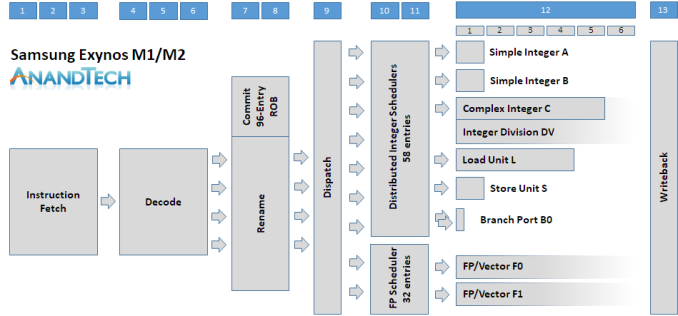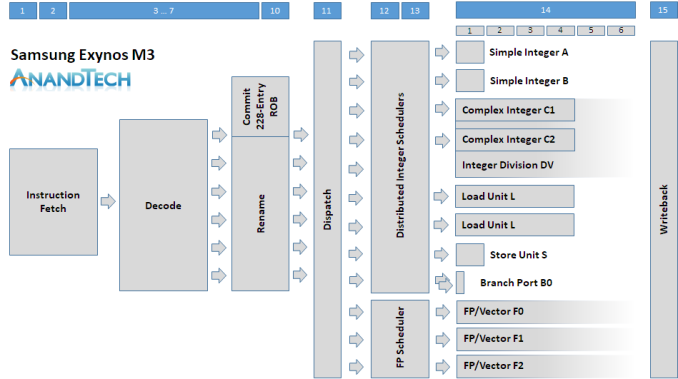The Samsung Exynos M3 - 6-wide Decode With 50%+ IPC Increase
by Andrei Frumusanu on January 23, 2018 1:30 PM EST- Posted in
- Mobile
- CPUs
- Samsung
- Smartphones
- Exynos 9810
- Exynos M3

The Exynos 9810 was one of the first big announcements for 2018 and it was quite an exciting one. Samsung’s claims of doubling single-threaded performance was definitely an eye-catching moment and got a lot of attention. The new SoC sports four of Samsung’s third-generation Exynos M3 custom architecture cores running at up to 2.9GHz, alongside four Cortex A55 cores at 1.9GHz.
Usually Samsung LSI’s advertised target frequency for the CPUs doesn’t necessarily mean that the mobile division will release devices with the CPU running at those frequencies. The Exynos 8890 was advertised by SLSI to run up to 2.7GHz, while the S7 limited it to 2.6GHz. The Exynos M2’s DVFS tables showed that the CPU could go up to 2.8GHz but was rather released with a lower and more power efficient 2.3GHz clock. Similarly, it’s very possible we might see more limited clocks on an eventual Galaxy S9 with the Exynos 9810.
Of course even accounting for the fact that part of Samsung’s performance increase claim for the Exynos 9810 comes from the clockspeed jump from 2.3GHz to 2.9GHz, that still leave a massive performance discrepancy towards the goal of doubling single-threaded performance. Thus, this performance delta must come from the microarchitectural changes. Indeed the effective IPC increase must be in the 55-60% range for the math to make sense.
With the public announcement of the Exynos 9810 having finally taken place, Samsung engineers are now free to release information on the new M3 CPU microarchitecture. One source of information that’s been invaluable over the years into digging into the deeper working of CPU µarch’s are the companies' own submissions to open-source projects such as the GCC and LLVM compilers. Luckily Samsung is a fantastic open-source contributor and has yesterday posted the first patches describing the machine model for the M3 microarchitecture.
To better visualise the difference between the previous microarchitectures and the new M3, we take a step back in time to have a look what the high-level pipeline configuration of the Exynos M1/M2:
At heart the Exynos M1 and M2 microarchitectures are based on a 4-wide in-order stage for decode and dispatch. The wide decode stage was rather unusual at the time as ARM’s own Cortex A72 and A73 architectures made due with respectively 3 and 2-wide instruction decoders. With the Exynos M1/M2 being Samsung LSI’s first in-house microarchitecture it’s possible that the front-end wasn’t as advanced as ARM’s, as the latter’s 2-wide A73 microarchitecture was more than able to keep up in terms of IPC against the 4-wide M1 & M2. Samsung’s back-end for the M1 and M2 included 9 execution ports:
- Two simple ALU pipelines capable of integer additions.
- A complex ALU handling simple operations as well as integer multiplication and division.
- A load unit port
- A store unit port
- Two branch prediction ports
- Two floating point and vector operations ports leading to two mixed capability pipelines
The M1/M2 were effectively 9-wide dispatch and execution machines. In comparison the A73 dispatches up to 8 micro-ops into 7 pipelines and the A75 dispatches up to 11 µops into 8 pipelines, keeping in mind that we’re talking about very different microarchitectures here and the execution capabilities between the pipelines differ greatly. From fetch to write-back, the M1/M2 had a pipeline depth of 13 stages which is 2 stages longer than that of the A73 and A75, resulting is worse branch-misprediction penalties.
This is only a rough overview of the M1/M2 cores, Samsung published a far more in depth microarchitectural overview at HotChips 2016 which we’ve covered here.
The Exynos M3 differs greatly from the M1/M2 as it completely overhauls the front-end and also widens the back-end. The M3 front-end fetch, decode, and rename stages now increases in width by 50% to accommodate a 6-wide decoder, making the new microarchitecture among one of the widest in the mobile space alongside Apple’s CPU cores.
This comes at a cost however, as some undisclosed stages in the front-end become longer by 2 cycles, increasing the minimum pipeline depth from fetch to writeback from 13 to 15 stages. To counteract this, Samsung must have improved the branch predictor, however we can’t confirm for sure what individual front-end stage improvements have been made. The reorder buffer on the rename stage has seen a massive increase from 96 entries to 228 entries, pointing out that Samsung is trying to vastly increase their ability to extract instruction level parallelism to feed their back-end execution units.
The depiction of the schedulers are my own best guess on how the M3 looks like, as it seemed to me like the natural progression from the M1 configuration. What we do know is that the core dispatches up to 12 µops into the schedulers and we have 12 execution ports:
- Two simple ALU pipelines for integer additions, same as on the M1/M2.
- Two complex ALUs handling simple integer additions and also multiplication and division. The doubling of the complex pipelines means that the M3 has now double the integer multiplication throughput compared to the M1/M2 and a 25% increase in simple integer arithmetic.
- Two load units. Again, the M3 here doubles the load capabilities compared to the M1 and M2.
- A store unit port, same as on the M1/M2.
- Two branch prediction ports, likely the same setup as on the M1/M2, capable of feeding the two branches/cycle the branch prediction unit is able to complete.
- Instead of 2 floating point and vector pipelines, the M3 now includes 3 of them, all of them capable of complex operations, theoretically vastly increasing FP throughput.
The simple ALU pipelines already operate at single-cycle latencies so naturally there’s not much room for improvement there. On the side of the complex pipelines we still see 4-cycle multiplications for 64-bit integers, however integer division has been greatly improved from 21 cycles down to 12 cycles. I’m not sure if the division unit reserves both complex pipelines or only one of them, but what is clear as mentioned before, integer multiplication execution throughput is doubled and the additional complex pipe also increases simple arithmetic throughput from 3 to 4 ADDs.
The load units have been doubled and their load latency remains 4 cycles for basic operations. The Store unit also doesn’t seem to change in terms of its 1-cycle latency for basic stores.
The floating point and vector pipelines have seen the most changes in the Exynos M3. There are 3 pipelines now with distributed capabilities between them. Simple FP arithmetic operations and multiplication see a three-fold increase in throughput as all pipelines now offer the capability, compared to only one for the Exynos M1/M2. Beyond tripling the throughput, the latency of FP additions and subtractions (FADD, FSUB) is reduced from 3 cycles down to 2 cycles. Multiplication stays at a 4-cycle latency.
Floating point division sees a doubling of the throughput as two of the three pipelines are now capable of the operations, and latency has also been reduced from 15 cycles down to 12 cycles. Cryptographic throughput of AES instruction doubles as well as two of the 3 pipelines are able to execute them. SHA instruction throughput remains the same. For simple vector operations we see a 50% increase in throughput due to the additional pipeline.
We’re only scratching the surface of what Samsung’s third-generation CPU microarchitecture is bringing to the table, but already one thing is clear: SLSI’s claim of doubling single-threaded performance does not seem farfetched at all. What I’ve covered here are only the high-level changes the in the pipeline configurations and we don’t know much at all about the improvements on the side of the memory subsystem. I’m still pretty sure that we’ll be looking at large increases in the cache sizes up to 512KB private L2’s for the cores with a large 4MB DSU L3. Given the floating point pipeline changes I’m also expecting massive gains for such workloads. The front-end of the M3 microarchitecture is still a mystery so here’s hoping that Samsung will be able to re-attend Hot Chips this year for a worthy follow-up presentation covering the new design.
With all of these performance improvements, it’s also expected that the power requirements of the core will be greatly beyond those of existing cores. This seems a natural explanation for the two-fold single-core performance increase while the multi-core improvement remains at 40% - running all cores of such a core design at full frequency would indeed showcase some very high TDP numbers.
If all these projections come to fruition, I have no idea how Samsung’s mobile division is planning to equalise the CPU performance between the Exynos 9810 and against an eventual Snapdragon 845 variant of the Galaxy S9, short of finding ourselves in a best-case scenario for ARM’s A75 vs a worst-case for the new Exynos M3. With 2 months to go, we’ll have to wait & see what both Samsung mobile and Samsung LSI have managed to cook up.













60 Comments
View All Comments
lilmoe - Tuesday, January 23, 2018 - link
CPU designers have had a head start relative to the media though. They've known about the vulnerabilities long before. Would be interesting to know if any measures were actually taken.Ryan Smith - Tuesday, January 23, 2018 - link
"CPU designers have had a head start relative to the media though. They've known about the vulnerabilities long before. "Note that most of that head start was used to do research on the problem and potential solutions. The actual action window for the CPU vendors was relatively short, which is a problem given the very long development cycles for CPUs.
jospoortvliet - Thursday, January 25, 2018 - link
even if samsung had known a month before the researchers discovered the bugs they wouldn't have been able to do much I bet. Against Meltdown MAYBE. But sure not against Spectre - it will take years before vendors release the first CPU with serious protection against it I bet. Maybe a few quick fixes in the next gen but no real solutions get - it is so fundamental to how high end CPU cores work it will need real research to find solutions that won't simply kill performance.hescominsoon - Tuesday, January 23, 2018 - link
Probably. Mot cpu road-maps are at least a year long..sometimes two. it will be interesting to see if any company is going to throw out the millions or billions in R&D to rearchitect so soon.name99 - Tuesday, January 23, 2018 - link
The iPad is the interesting case.In principle Apple could ship updates in May or so with the A11X. But it's ALSO possible that they could simply drop that plan and ship new iPads in November or so, with an A12X. Point being that after learning about Meltdown/Spectre they used the A11X as something of a dummy, made various HW changes on it to see how they behave, and retrofitted those to the A12/A12X.
I'm not asserting that they did that, but they do have a flexibility along that dimension that pretty much no-one else has. The iPad doesn't have a hard schedule that everyone expects, and the A12X is probably designed in sync with the A12, even if it's only scheduled to be manufactured 6 months later.
Apple COULD decide (especially given their constant fsckups with macOS security) that the best way to regain some positive PR is to make a decision that the next chip they ship they can announce as being "the first CPU released that's designed to be free of Meltdown and Spectre vulnerabilities".
lilmoe - Tuesday, January 23, 2018 - link
You think there's a market for even faster iPads? I won't be surprised if Apple skips an upgrade cycle.name99 - Wednesday, January 24, 2018 - link
Uhh --- that's more or less what I said...phoenix_rizzen - Tuesday, January 23, 2018 - link
The Cortex-A75 is supposed to be vulnerable to the same Meltdown issue add Intel CPUs, according to ARM. Will be interesting to see if any of the devices using A75s or derivatives like Samsung M3 or the Kyro cores in the SD845 will be patched from the get-go. Or will we be waiting on Google to develop Android patches?jospoortvliet - Thursday, January 25, 2018 - link
I dont think this is an ARM derivative and while it accidentally might be resistant go meltdown it will 99.983% sure be vulnerable to all Spectre variants. I leave the tiny bit for the super small chance it is slightly less vulnerable to one or another spectre type issue.jjj - Tuesday, January 23, 2018 - link
Why are you assuming that Samsung will use Snapdragon?When they had a far better chip (SD810 times), they did not and now Samsung is likely to lose Qualcomm as a foundry customer too so, has Qualcomm hinted that Samsung is a customer for SD845?
Do hope they got single core turbo this time around, doesn't seem feasible to go with such a core at such clocks otherwise.